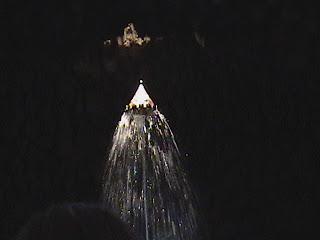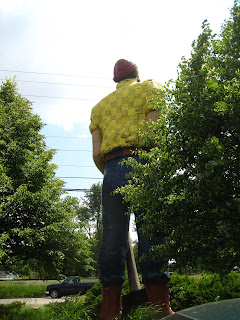London, England. Spring 2007.

530 steps to the Golden Gallery at the top of St. Paul's Cathedral, the highest accessible point of the building sat on the highest hill in London. 530 stone steps, wooden stairs, flat rises and winding staircases, all leading to this one place.
At the bottom of the stairs is a sign with a warning. "Five hundred and thirty steps," it says. "Possibly dangerous," it says. "Be aware," it says. I don't see how we could possibly resist.
Mom follows us up to the Whispering Gallery, which is considerably less than 530 steps, but that's as far as her knees will take her. We stand at the railing and strain our ears, trying to pick up the hushed conversations of the other sightseers. We hear plenty of breathy murmurs, but I can't make out any words.
Mom waves us off with a promise to meet us at the bottom, and my sister Sarah and I follow the handful of tourists brave enough to climb to the top. We duck under low-hanging wooden beams, squeeze through narrow stone corridors, blink when the air rushing through open windows stings our eyes, and squint through the gloomy near-hidden pathways. There's a small door at the end of one last steep staircase. Light streams in around the edges.
The wind blows fiercely this high up. Sarah's hair whips around her face, and she tucks as much of it as she can under her hat to keep it out of her eyes. I shaved my head a few weeks before, so I just pull the lapels of my coat close against my neck, fighting to keep out the chill.
There's a high wall to keep us all from plunging to our deaths, so we press our faces against the cut out openings, looking down on the street below. Little blips of humanity stroll the sidewalks, making way for the technicolor stream of oncoming traffic.

530 is more tiring than I anticipated. I lean against the wall, and feel the heat of the sun-warmed stone through my jacket.

And like all things, because it exists, it's covered in graffiti. I have no pen. If I had, Sarah and I might has snuck our initials onto a small corner, for posterity's sake. In twenty years time we could come back with our own children, discretely point at the little smudge on the side and say, "Look what your mothers did." If we've raised them right, they'll be publicly embarrassed, but secretly impressed.
530 is a smaller number going down than it was coming up. It feels a bit subversive, walking through the not-exactly-underbelly of the iconic church, that hidden place between the outer skin and the inner sanctum. You could win every game of hide and seek in here, if it weren't for the parade of tourists.
Mom's waiting for us with a smile after 1060 steps. "How are your knees?" she asks. Sarah and I chuckle lightly and make half-jokes about being old ladies. Mom just shakes her head, making small noises about kids these days.





















































